Design and Manufacturing of Adaptive Facades in a Life Cycle Approach: A Survey on Challenges and Solutions in the Italian Building Industry
Abstract
:1. Introduction
LCA Mapping of Adaptive Façades
2. Materials and Methods
- “Participant’s general information (part 1–part 2)”—on the location and type of activity and about experiences on sustainability, life cycle assessment or life cycle thinking as well as adaptive facade design (Part 1: Questions 1–7 and Part 2: Questions 15 and 16). Further open questions are provided to those who had a background on these topics to assess their knowledge degree. (Part 1: Questions 8–14 and Part 2: Questions 17–22);
- “Knowledge gaps and issues in building LCA”—this part is intended to identify how life cycle assessment is valued in the context of the activity carried out and the critical issues encountered in its use (Questions 23–28);
- “Issues on design and manufacturing of adaptive facades”—this section aims to obtain cross-cutting information regarding the sphere of influence of the Life Cycle assessment for early design goals and concerning the different life cycle phases of the adaptive envelope (Questions 29–33);
- “Evaluation of the usability of the LCA design tool”—these questions aim to explore design benefits in synergy with a list of general objectives and the degree of user-friendliness of the mapping. The interviewee is allowed to consult the online mapping’s graphics (Questions 34–42);
- “Survey publication and eventual involvement”—this section concerns further comments and recommendations and insights for future research, as well as for declarations of responsibility for the information collected (Questions 43–45).
3. Results
3.1. Participant’s General Information (Part 1)
3.2. Participant’s General Information (Part 2)
3.3. Knowledge Gaps and Issues in Building LCA
3.4. Issues on Design and Manufacturing of Adaptive Façades
3.5. Evaluation of the Usability of the LCA Design Tool
4. Discussion
- the feedback obtained is positively considered given the limited scope of the issues addressed. A cross-analysis on Part 1 and Part 2 shows that respondents are mainly designers/consultants whose degree of direct experience on LCA-type tools and sustainable building protocols is not related to designing adaptive facades. Despite that, the concern in the proposed subject of the survey (LCA and adaptive facades) has been common for the 73% of the interviewed;
- one of the main existing barriers to the application of LCA in the design phases is represented by the lack of awareness on environmental issues due to an absence of sustainable and long-term market models. This is the reason why Property managers and investors did not respond to the survey;
- one of the main gaps to the application of LCA is the lack of input data, especially regarding the use phase of adaptive fa cades (multiple-choice answer: 58% of interviewed).
- the analysis of the words used in the proposed classification system highlights that Autoreactive Building Skins are the most investigated and/or produced technology;
- beside energy efficiency and indoor environmental quality, designers are concerned by other life cycle performances such as maintenance/repair efficiency and recycling/reuse potential at the end of life phase (multiple-choice answer: both 53% of interviewed);
- despite that, among the proposed design goals that support an LCA of an adaptive facade does not emerge a determining factor;
- innovation is a priority as adaptivity is still a developing technology;
- the interest is distributed among the various activities of the stakeholders and increases for those involved in research and sustainability.
- the usefulness and usability of the mapping are verified, especially considering that the BIM environment is the basis of computerized optimization methods (one-choice answer: 83% of interviewed).
- the mapping is very or “on average” useful, in particular, to highlight problem areas during the early design phase (one choice answer: 94% of interviewed).
5. Conclusions
Funding
Institutional Review Board Statement
Informed Consent Statement
Data Availability Statement
Conflicts of Interest
References
- Rogelj, J.; Shindell, D.; Jiang, K. Mitigation Pathways Compatible with 1.5 °C in the Context of Sustainable Development. Available online: https://www.ipcc.ch/site/assets/uploads/sites/2/2019/02/SR15_Chapter2_Low_Res.pdf (accessed on 20 January 2020).
- 2018 Global Status Report: Towards a Zero-Emission, Efficient and Resilient Building and Construction Sector. Available online: https://www.worldgbc.org/news-media/2018-global-status-report-towards-zero-emission-efficient-and-resilient-buildings-and (accessed on 20 January 2020).
- Directive (EU) 2018/844 of the European Parlament and of the Council of 30 May 2018 Amending Directive 2010/31/EU on the Energy Performance of Buildings and Directive 2012/27/EU on Energy Efficiency. Available online: https://eur-lex.europa.eu/legal-content/IT/TXT/?uri=CELEX%3A32018L0844 (accessed on 20 January 2020).
- Clifford, D.; Zupan, R.; Brigham, J.; Beblo, R.; Whittock, M.; Davis, N. Application of the dynamic characteristics of shape-memory polymers to climate adaptive building facades. In Proceedings of the 12th International Conference on Advanced Building Skins, Bern, Switzerland, 2–3 October 2017. [Google Scholar]
- Masri, Y. Intelligent Building Envelopes: Design and Applications. In Proceedings of the International Conference on Building Envelope Design and Technology, Graz Advanced Building Skins, Graz, Austria, 23–24 April 2015. [Google Scholar]
- Velikov, K.; Thün, G. Responsive Building Envelopes: Characteristics and evolving paradigms. In Design and Construction of High Performance Homes; Trubiano, F., Ed.; Routledge: London, UK; New York, NY, USA, 2018; pp. 75–92. [Google Scholar]
- Wang, J.; Beltrán, L.; Kim, J. From Static to Kinetic: A Review of Acclimated Kinetic Building Envelopes. In Proceedings of the World Renewable Energy Forum, WREF 2012, Annual Conference, Denver, CO, USA, 13–17 May 2012. [Google Scholar]
- Attia, S.; Bilir, S.; Safy, T.; Struck, C.; Loonen, R.; Goia, F. Current Trends and Future Challenges in the Performance Assessment of Adaptive Façade Systems. Energy Build. 2018, 179, 165–182. [Google Scholar] [CrossRef] [Green Version]
- Panteli, C.; Kylili, A.; Stasiuliene, L.; Seduikyte, L.; Fokaides, P.A. A framework for building overhang design using Building Information Modeling and Life Cycle Assessment. J. Build. Eng. 2018, 20, 248–255. [Google Scholar] [CrossRef]
- Schlanbusch, R.D.; Fufa, S.M.; Häkkinen, T.; Vares, S.; Birgisdottir, H.; Ylmén, P. Experiences with LCA in the Nordic Building Industry. Challenges, Needs and Solutions. Energy Procedia 2016, 96, 82–93. [Google Scholar] [CrossRef] [Green Version]
- COST Action TU1403. 2018. Available online: http://tu1403.eu/?page_id=32 (accessed on 20 January 2020).
- Poljanšek, M. Building Information Modelling (BIM) standardization. In JRC Technical Report; EUR 28977 EN; European Commission: Luxembourg, 2017. [Google Scholar] [CrossRef]
- Röck, M.; Hollberg, A.; Habert, G.; Passer, A. LCA and BIM: Integrated assessment and visualization of building elements’ embodied impacts for design guidance in early stages. Procedia CIRP 2018, 69, 218–223. [Google Scholar] [CrossRef]
- Volk, R.; Stengel, J.; Schultmann, F. Building Information Modeling (BIM) for existing buildings—Literature review and future needs. Autom. Constr. 2014, 38, 109–127. [Google Scholar] [CrossRef] [Green Version]
- Hollberg, A.; Ruth, J. LCA in architectural design—A parametric approach. Int. J. Life Cycle Assess 2016, 21, 943–960. [Google Scholar] [CrossRef] [Green Version]
- Bueno, C.; Fabricio, M.M. Comparative analysis between a complete LCA study and results from a BIM-LCA plug-in. Autom. Constr. 2018, 90, 188–200. [Google Scholar] [CrossRef]
- Soust-Verdaguer, B.; Llatas, C.; García-Martínez, A. Critical review of BIM-based LCA method to buildings. Energ. Build. 2017, 136, 110–120. [Google Scholar] [CrossRef]
- One Click LCA. 2020. Available online: https://www.oneclicklca.com/ (accessed on 20 January 2020).
- Tally. 2020. Available online: https://choosetally.com/ (accessed on 26 January 2020).
- Basic, S.; Hollberg, A.; Galimshina, A.; Habert, G. A design integrated parametric tool for real-time Life Cycle Assessment—Bombyx project. IOP Conf. Ser. Earth Environ. Sci. 2019, 323, 012112. [Google Scholar] [CrossRef]
- Cavalliere, C.; Dell’Osso, G.R.; Pierucci, A.; Iannone, F. Life cycle assessment data structure for building information modeling. J. Clean Prod. 2018, 199, 193–204. [Google Scholar] [CrossRef]
- Pierucci, A.; Dell’Osso, G.R.; Cavalliere, C. Il Management del Flusso Informativo Delle Costruzioni Mediante Valutazioni LCA in Sostenibilità Ambientale Economia Circolare e Produzione Edilizia; Maggioli: Milano, Italy, 2015. [Google Scholar]
- Battisti, A.; Persiani, S.G.L.; Crespi, M. Review and Mapping of Parameters for the Early Stage Design of Adaptive Building Technologies through Life Cycle Assessment Tools. Energies 2019, 12, 1729. [Google Scholar] [CrossRef] [Green Version]
- Crespi, M.; Persiani, S.G.L.; Battisti, A. Mapping of LCA parameters as a tool for the design of sustainable cycle-based adaptive building skins. In Proceedings of the 12th International Conference on Advanced Building Skins, Bern, Switzerland, 2–3 October 2017. [Google Scholar]
- Barozzi, M.; Lienhard, J.; Zanelli, A.; Monticelli, C. The sustainability of adaptive envelopes: Developments of kinetic Architecture. Procedia Eng. 2016, 155, 275–284. [Google Scholar] [CrossRef] [Green Version]
- Piccoli, E.; Dama, A.; Dolara, A.; Leva, S. Experimental validation of a model for PV systems under partial shading for building integrated applications. J. Sol. 2019, 183, 356–370. [Google Scholar] [CrossRef]
- Romano, R.; Aelenei, L.; Aelenei, D.; Mazzucchelli, E.S. What is an Adaptive Façade? Analysis of Recent Terms and Definitions from an International Perspective. J. Facade Des. Eng. 2018, 6, 65–76. [Google Scholar] [CrossRef]
- Ghosh, A. Potential of building integrated and attached/applied photovoltaic (BIPV/BAPV) for adaptive less energy-hungry building’s skin: Acomprehensive review. J. Clean Prod. 2020, 276, 123343. [Google Scholar] [CrossRef]
- Kuru, A.; Oldfield, P.; Bonser, S.; Fiorito, F. Biomimetic adaptive building skins: Energy and environmental regulation in buildings. Energy Build. 2019, 205, 109544. [Google Scholar] [CrossRef]
- Foged, I.W. Environmental Tectonics: Matter Based Architectural Computation. Ph.D. Thesis, Aalborg Universitet, Aalborg, Denmark, 2015. [Google Scholar] [CrossRef]
- Hensel, M.U. Performance-Oriented Architecture: Rethinking Architectural Design and the Built Environment; AD Wiley: Brisbane, Australia, 2015. [Google Scholar] [CrossRef]
- Menges, A. Biomimetic design processes in architecture: Morphogenetic and evolutionary computational design. Bioinspir. Biomimetics 2012, 7, 015003. Available online: https://iopscience.iop.org/article/10.1088/1748-3182/7/1/015003/meta (accessed on 30 September 2021). [CrossRef]
- Persiani, S.G.L.; Battisti, A.; Wolf, T. Recurring moving patterns in nature for a biomimetical optimization of autoreactive systems. In Proceedings of the International Association for Shell and Spatial Structures (IASS) Symposium, Amsterdam, The Netherlands, 17–20 August 2015. [Google Scholar]
- Persiani, S.G.L.; Battisti, A.; Wolf, T. Autoreactive architectural facades—Discussing unpowered kinetic building skins and the method of evolutionary optimization. In Proceedings of the 11th Conference on Adaptive Building Skins, Bern, Switzerland, 28–29 October 2016. [Google Scholar]
- Al-Obaidi, K.M.; Ismail, M.A.; Hussein, H.; Rahman, A.M.A. Biomimetic building skins: An adaptive approach. Renew. Sustain. Energy Rev. 2017, 79, 1472–1491. [Google Scholar] [CrossRef]
- Cruz, E.; Hubert, T.; Chancoco, G.; Naim, O.; Chayaamor-Heil, N.; Cornette, R.; Menezo, C.; Badarnah, L.; Raskin, K.; Aujard, F. Design processes and multi-regulation of biomimetic building skins: A comparative analysis. Energy Build. 2021, 246, 111034. [Google Scholar] [CrossRef]
- Survey Monkey. Available online: https://it.surveymonkey.com (accessed on 26 January 2020).
- Balouktsi, M.; Lützkendorf, T.; Röck, M.; Passer, A.; Reisinger, T.; Frischknecht, R. Survey results on acceptance and use of Life Cycle Assessment among designers in world regions: IEA EBC Annex 72. IOP Conf. Ser. Earth Environ. Sci. 2020, 588, 032023. [Google Scholar] [CrossRef]
- Rasmussen, F.N.; Malmqvist, T.; Birgisdóttir, H. Drivers, barriers and development needs for LCA in the Nordic building sector—A survey among professionals. IOP Conf. Ser. Earth Environ. Sci. 2020, 588, 032022. [Google Scholar] [CrossRef]
- LoRe-LCA. Available online: https://www.sintef.no/projectweb/lore-lca/ (accessed on 26 January 2020).
- James, K.L.; Grant, T.; Sonneveld, K. Stakeholder involvement in australian paper and packaging waste management LCA study. Int. J. Life Cycle Assess. 2002, 7, 151–157. [Google Scholar] [CrossRef]
- Kara, S.; Ibbotson, S.; Kayis, B. Sustainable product development in practice: An international survey. J. Manuf. Technol. Manag. 2014, 25, 848–872. [Google Scholar] [CrossRef]
- Crespi, M.; Persiani, S.G.L. Rethinking Adaptive Building Skins from a Life Cycle Assessment perspective. JFDE 2019, 7, 21–43. [Google Scholar] [CrossRef]
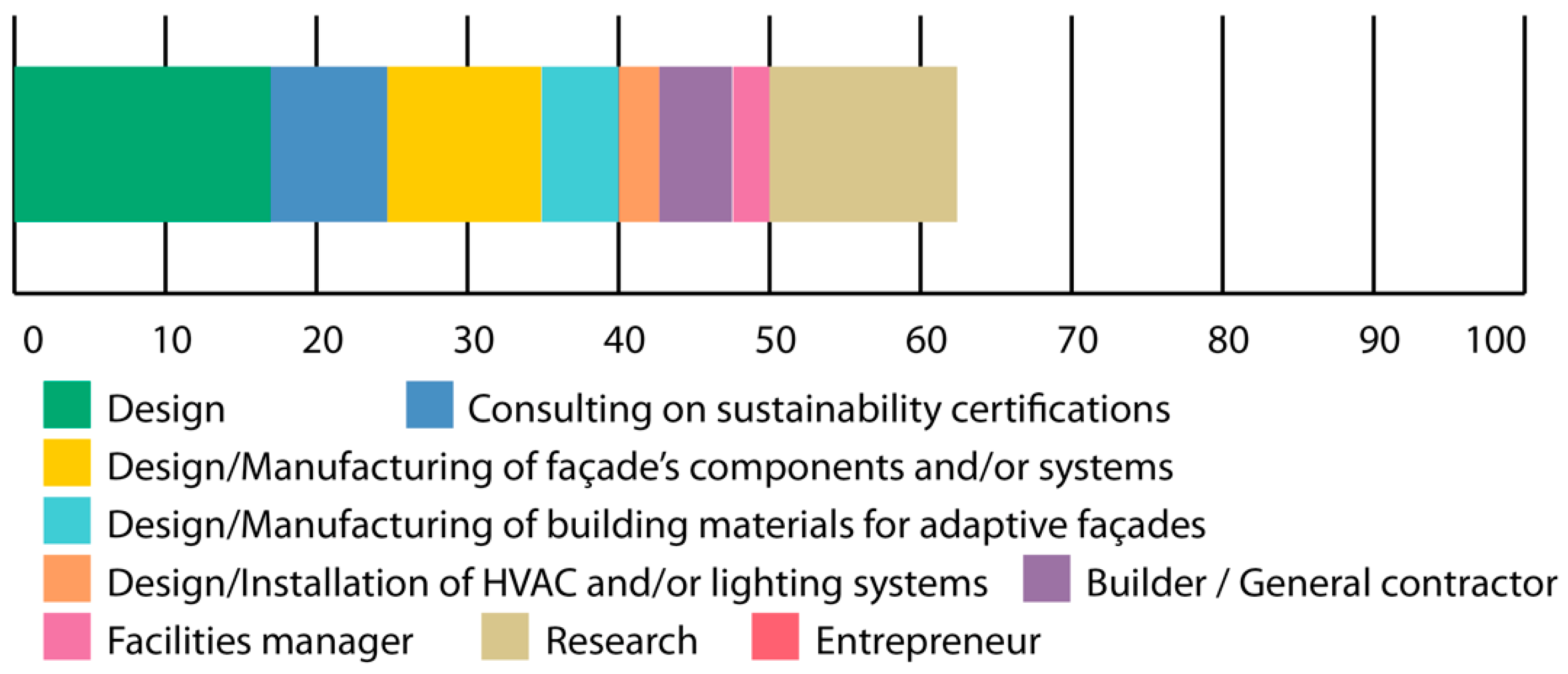
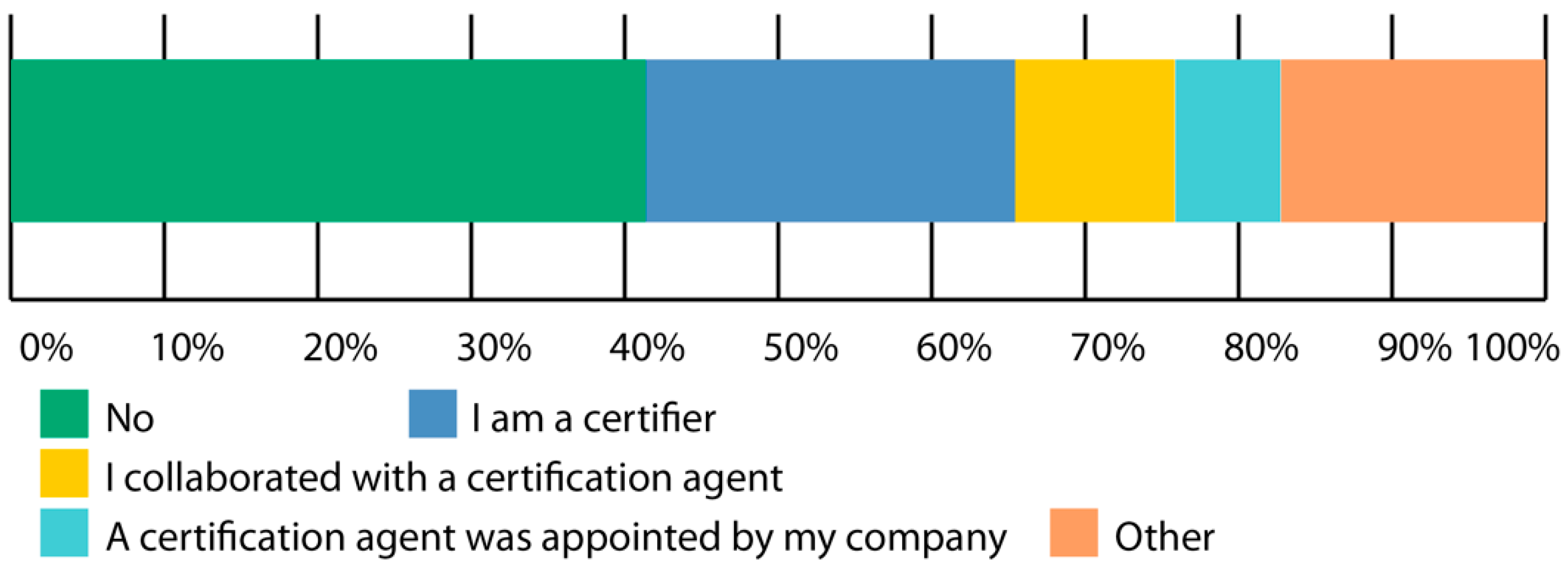



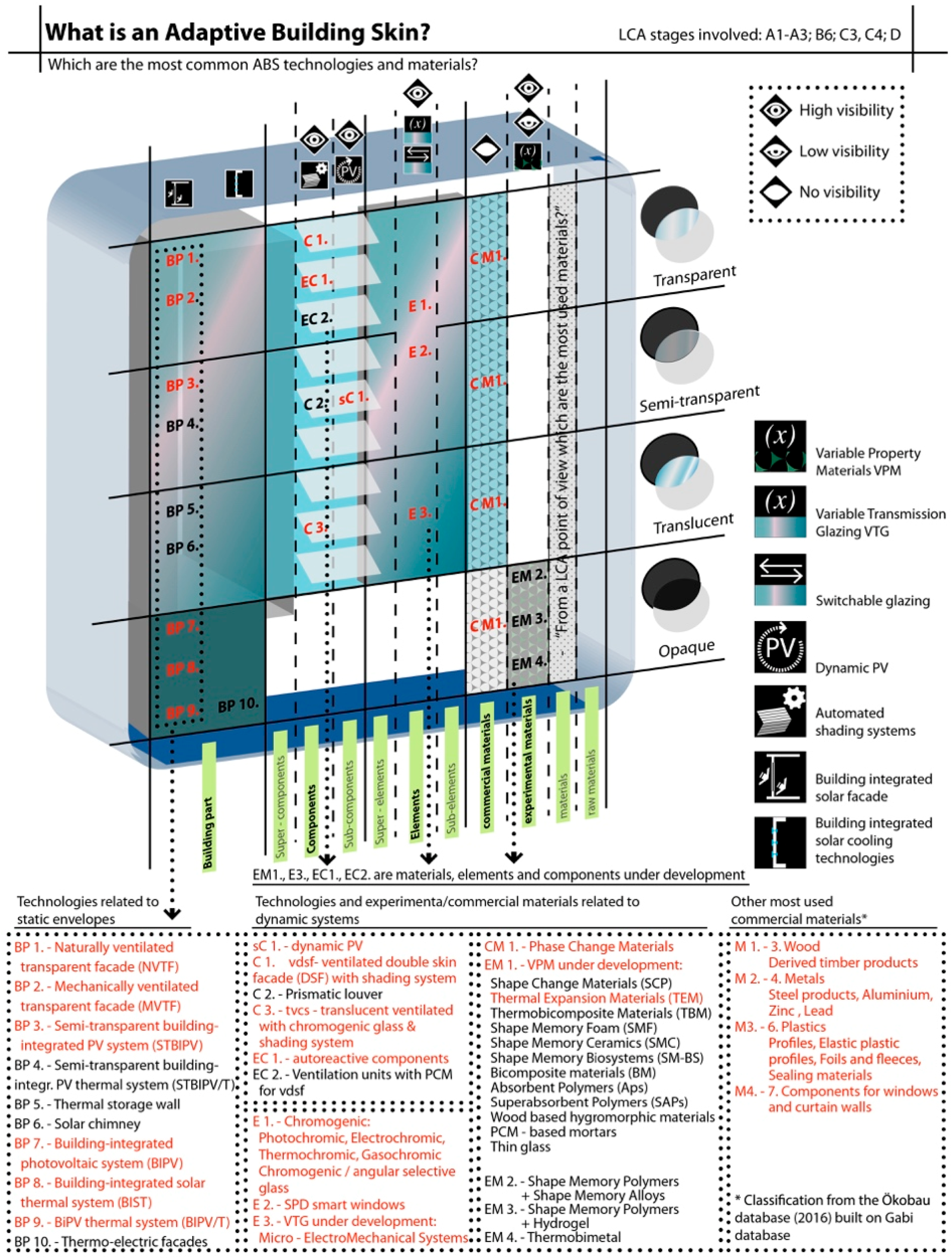



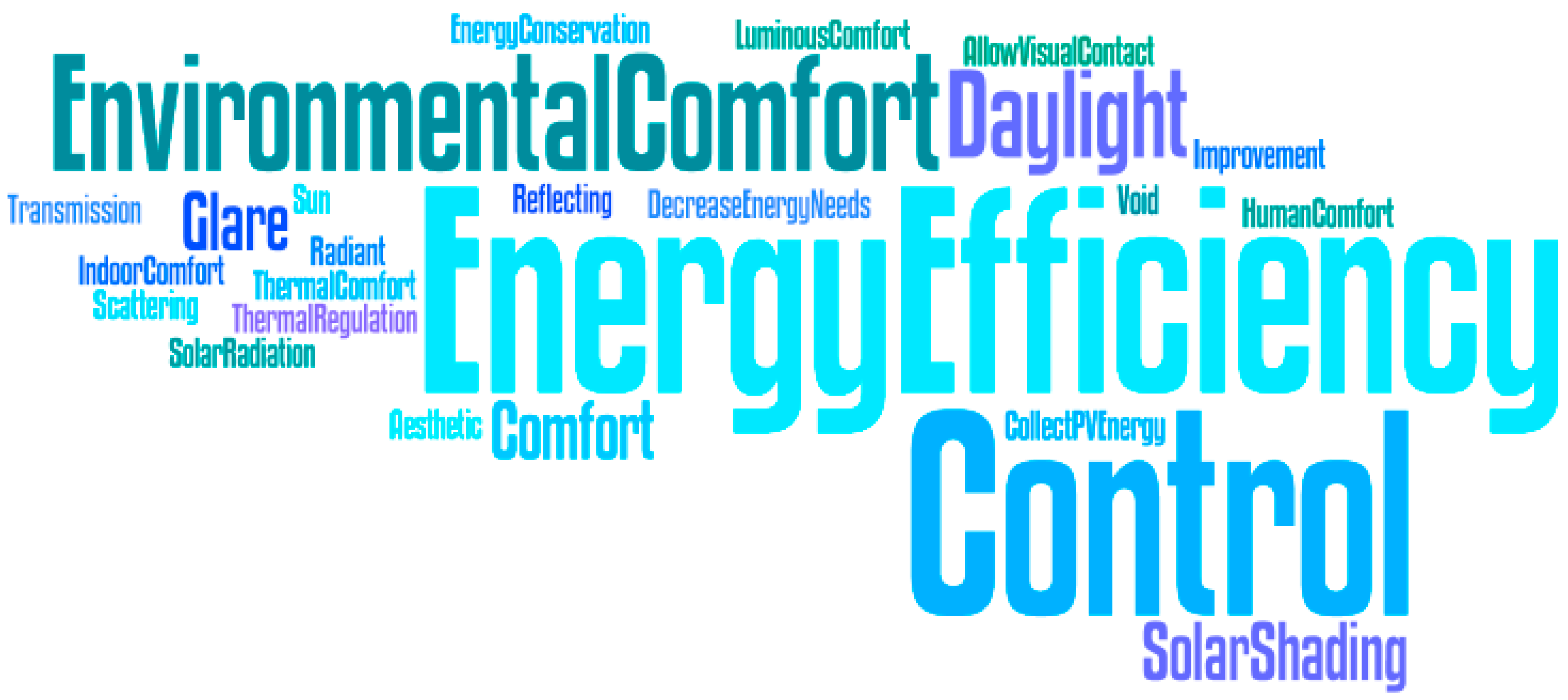
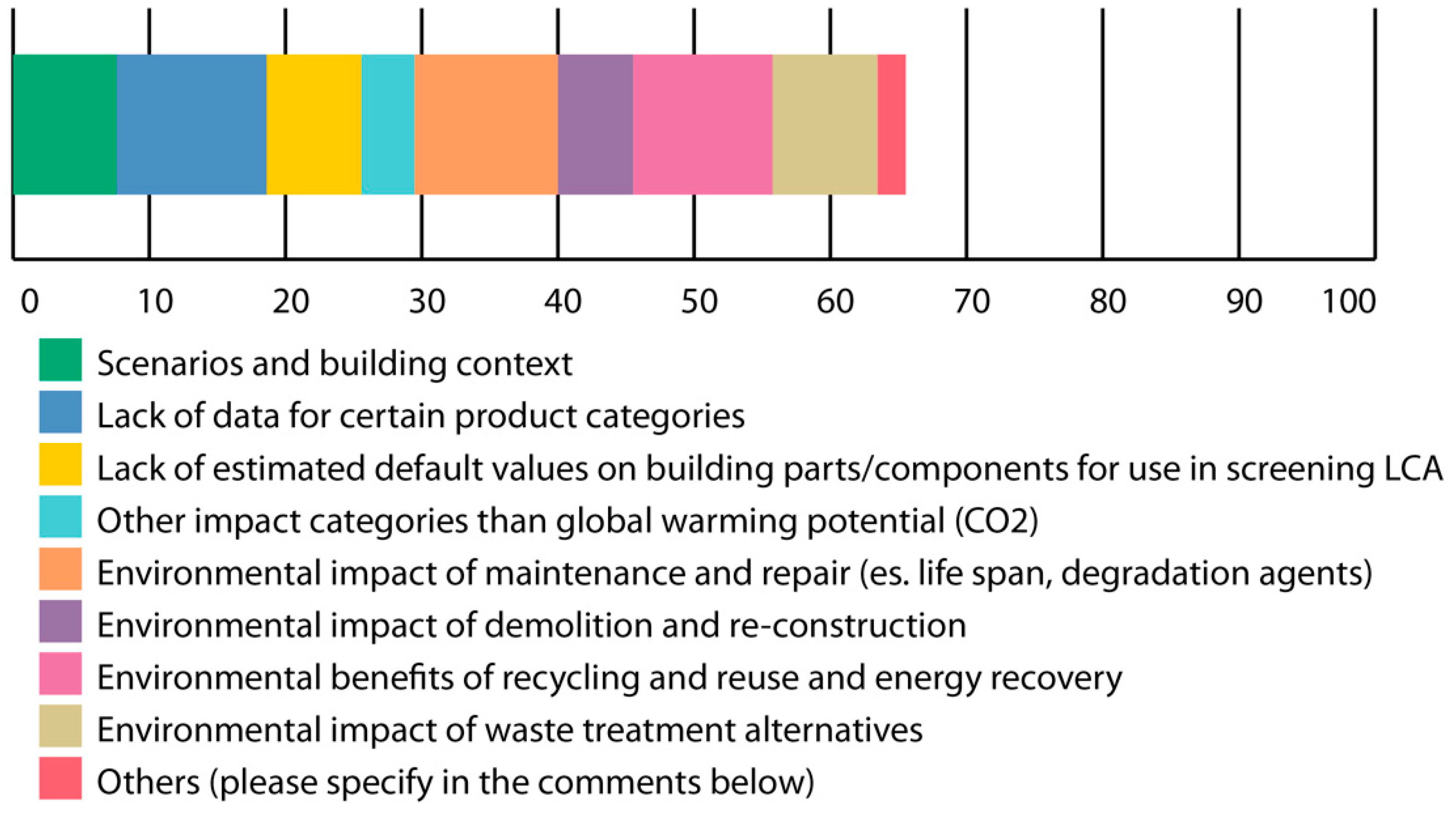

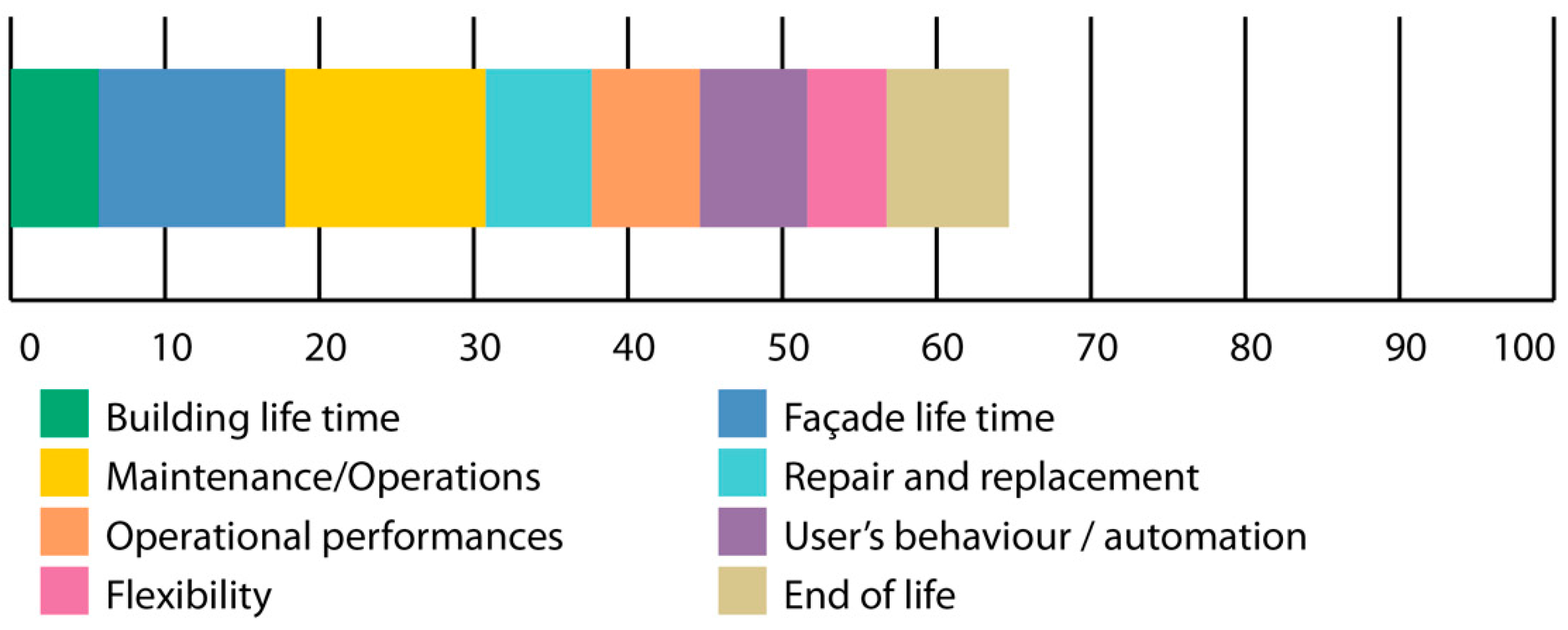

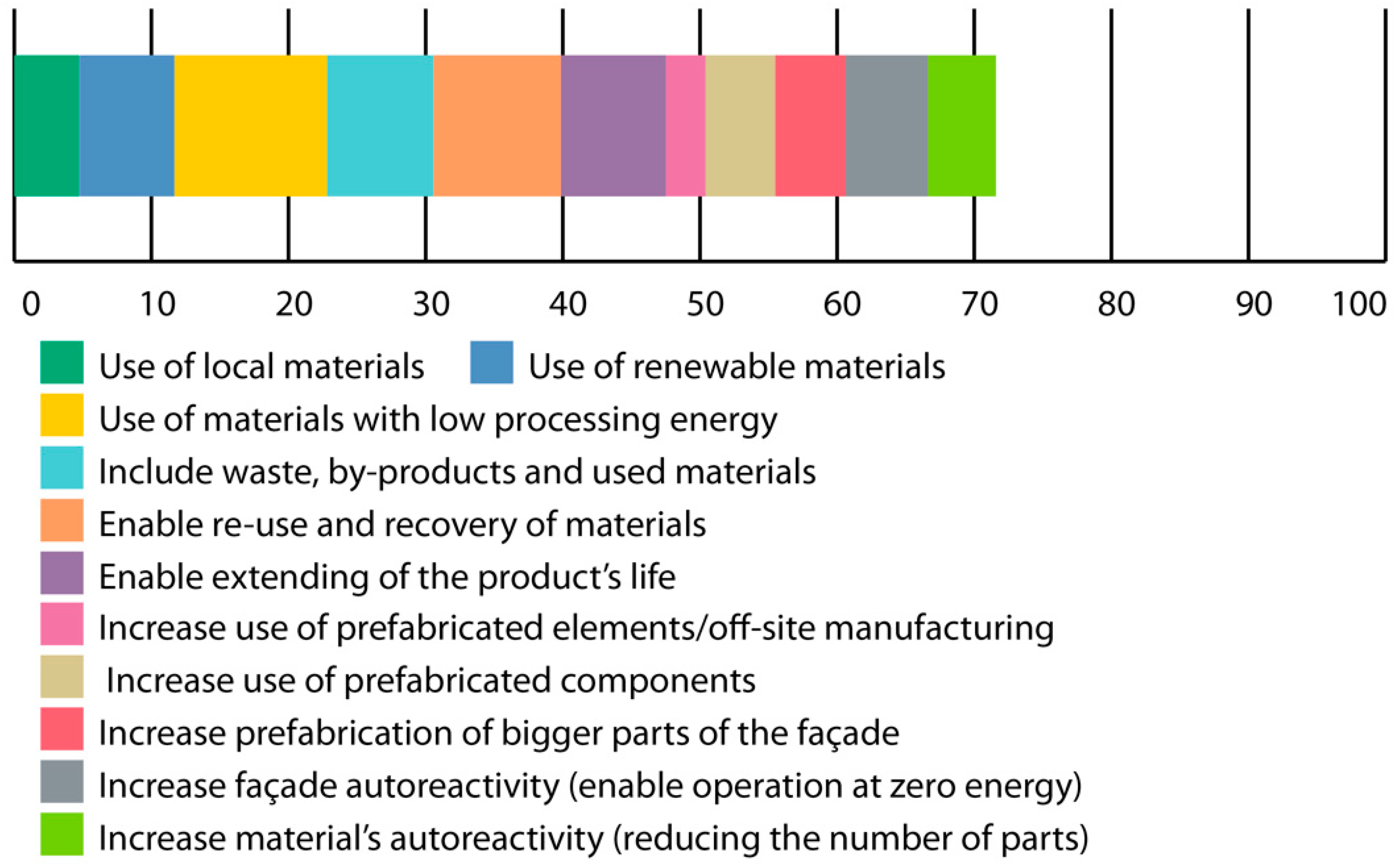
Publisher’s Note: MDPI stays neutral with regard to jurisdictional claims in published maps and institutional affiliations. |
© 2021 by the author. Licensee MDPI, Basel, Switzerland. This article is an open access article distributed under the terms and conditions of the Creative Commons Attribution (CC BY) license (https://creativecommons.org/licenses/by/4.0/).
Share and Cite
Crespi, M. Design and Manufacturing of Adaptive Facades in a Life Cycle Approach: A Survey on Challenges and Solutions in the Italian Building Industry. Architecture 2021, 1, 69-82. https://doi.org/10.3390/architecture1020007
Crespi M. Design and Manufacturing of Adaptive Facades in a Life Cycle Approach: A Survey on Challenges and Solutions in the Italian Building Industry. Architecture. 2021; 1(2):69-82. https://doi.org/10.3390/architecture1020007
Chicago/Turabian StyleCrespi, Manuela. 2021. "Design and Manufacturing of Adaptive Facades in a Life Cycle Approach: A Survey on Challenges and Solutions in the Italian Building Industry" Architecture 1, no. 2: 69-82. https://doi.org/10.3390/architecture1020007
APA StyleCrespi, M. (2021). Design and Manufacturing of Adaptive Facades in a Life Cycle Approach: A Survey on Challenges and Solutions in the Italian Building Industry. Architecture, 1(2), 69-82. https://doi.org/10.3390/architecture1020007





